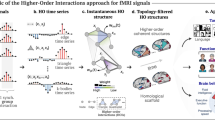Abstract
The connectivity network with direction of brain is a significant work to reveal interaction and coordination between different brain areas. Because Granger causality model can explore causal relationship between time series, the direction of the network can be specified when the model is applied to connectivity network of brain. Although the model has been used in EEG time sires more and more, it was seldom used in fMRI time series because of lower time resolution of fMRI time series. In this paper, we introduced a pre-processing method to fMRI time series in order to alleviate the magnetic disturbance, and then expand the time series to fit the requirement of time-variant algorism. We applied recursive least square (RLS) algorithm to estimate time-variant parameters of Granger model, and introduced a time-variant index to describe the directional connectivity network in a typical finger tapping fMRI experiment. The results showed there were strong directional connectivity between the activated motor areas and gave a possibility to explain them.
Preview
Unable to display preview. Download preview PDF.
Similar content being viewed by others
References
Granger, C.W.J.: Investigating causal relations by econometric models and cross-spectral methods. Econometrica 37, 424–438 (1969)
Kaminski, M.J., Ding, M., Truccolo, W.A., Bressler, S.L.: Evaluating causal relations in neural systems: Granger causality, directed transfer function and statistical assessment of significance. Biol. Cybern. 85, 145–157 (2001)
Goebel, R., Roebroeck, A., Kim, D.S., Formisano, E.: Investigating directed cortical interactions in time-resolved fMRI data using vector autoregressive modeling and Granger causality mapping. Magn. Reson. Imaging 21, 1251–1261 (2003)
Moller, E., Schack, B., Arnold, M., Witte, H.: Instantaneous multivariate EEG coherence analysis by means of adaptive high-dimensional autoregressive models. J. Neurosci. Methods 105, 143–158 (2001)
Ding, M., Bressler, S.L., Yang, W., Liang, H.: Short-window spectral analysis of cortical event-related potentials by adaptive multivariate autoregressive modelling: data preprocessing, model validation, and variability assessment. Biol. Cybern. 83, 35–45 (2000)
van de Ven, V.G., Formisano, E., Prvulovic, D., et al.: Functional Connectivity as Revealed by Spatial Independent Component Analysis of fMRI Measurements During Rest. Hum. Brain Mapp. 22, 165–178 (2004)
Astolfi, L., Cincotti, F., Mattia, D., et al.: Estimation of the effective and functional human cortical connectivity with structural quation modeling and directed transfer function applied to high-resolution EEG. Magn. Reson. Imaging 22, 1457–1470 (2004)
Geweke, J.: Measurement of linear dependence and feedback between multiple time series. J. Amer. Statist. Assoc. 77, 304–324 (1982)
Brockwell, P.J., Davis, R.A.: Time Series: Theory and Methods, pp. 417–420. Springer, New York (1987)
Haykin, S.: Adaptive Filter Theory, pp. 381–407. Prentice-Hall, Englewood Cliffs (1986)
Theiler, J., Eubank, Longtin, S.J., Galdrikian, B., Farmer, J.D.: Testing for nonlinearity in time series: The method of surrogate data. Phys. D 58, 77–94 (1992)
Wiley, J.: Programs for Digital Signal Processing. IEEE Press, New York (1979)
Author information
Authors and Affiliations
Editor information
Editors and Affiliations
Rights and permissions
Copyright information
© 2006 Springer-Verlag Berlin Heidelberg
About this paper
Cite this paper
Wen, XT., Zhao, XJ., Yao, L., Wu, X. (2006). Applications of Granger Causality Model to Connectivity Network Based on fMRI Time Series. In: Jiao, L., Wang, L., Gao, Xb., Liu, J., Wu, F. (eds) Advances in Natural Computation. ICNC 2006. Lecture Notes in Computer Science, vol 4221. Springer, Berlin, Heidelberg. https://doi.org/10.1007/11881070_31
Download citation
DOI: https://doi.org/10.1007/11881070_31
Publisher Name: Springer, Berlin, Heidelberg
Print ISBN: 978-3-540-45901-9
Online ISBN: 978-3-540-45902-6
eBook Packages: Computer ScienceComputer Science (R0)




